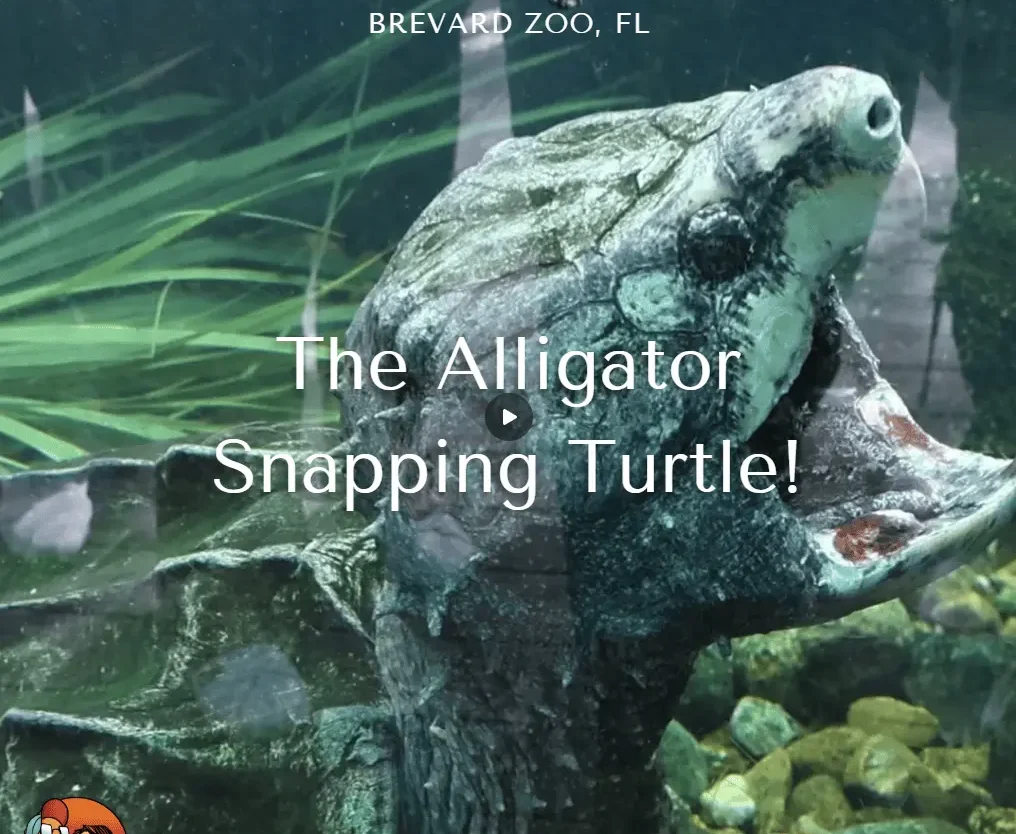As we continued our exploration of Brevard Zoo, and after the playful lemur and the majestic okapi had thoroughly mesmerized us, we unexpectedly stumbled upon an exhibit. It initially made me question whether its inhabitant was even alive! This was the enclosure of the Alligator Snapping Turtle. For a good few minutes, this prehistoric-looking creature remained completely still. It was a silent sentinel patiently guarding its watery domain.
First Impressions: A Living Stone
My very first impression was one of profound stillness, almost as if a weathered rock had settled permanently at the bottom of the tank. Moreover, its shell was remarkably rugged and textured. It closely resembled the bark of an old, gnarled tree. Adding to its imposing presence was its massive head, complete with a powerful-looking beak that hinted at hidden strength. However, it was only upon closer inspection, as we peered intently into its seemingly lifeless open mouth, that we noticed something truly peculiar. A small, worm-like appendage on its tongue gently wiggled, a subtle movement in an otherwise static scene. Consequently, it finally dawned on us: this seemingly inanimate being was indeed very much alive. In fact, its profound stillness was a key component of its fascinating and effective hunting strategy.
Unveiling the Ancient Mariner
Learning about the Alligator Snapping Turtle at Brevard Zoo truly opened my eyes to the wonders of the natural world. This remarkable creature is a true relic of the past, a living dinosaur that has roamed the waterways of North America for countless millions of years. Furthermore, its scientific name, Macrochelys temminckii, aptly speaks to its impressive size. “Macro” means large and “chelys” means turtle. Large it undeniably is! Indeed, these turtles rank among the heaviest freshwater turtles found anywhere in the world. For instance, males can reach impressive weights of over 200 pounds. Their shell lengths can exceed two feet, making them a truly substantial reptile.
The Art of the Ambush: A Master Hunter
What truly sets the Alligator Snapping Turtle apart from other turtles is its unique and highly effective hunting technique. As we ourselves witnessed, it primarily employs a classic ambush strategy, lying completely motionless at the bottom of murky waters. Crucially, that small, worm-like appendage on its tongue, scientifically known as a lingual lure, is the central key to its hunting success. By subtly wiggling this fleshy bait, it cleverly mimics a small worm. This entices unsuspecting fish and other small aquatic creatures to venture closer, mistakenly believing they’ve discovered an easy and defenseless meal. Then, with astonishing speed, in a lightning-fast strike, the powerful jaws snap shut. They securely trap its unsuspecting prey. This incredibly patient and cunning method not only conserves the turtle’s precious energy but also allows it to thrive effectively within its chosen environment.
Formidable Features and Respectful Distance
The powerful beak of the Alligator Snapping Turtle is yet another truly remarkable feature of this ancient creature. Exceptionally strong and razor-sharp, its beak perfectly adapts it for efficiently crushing the sturdy shells of mollusks and crustaceans. Moreover, these shelled creatures also constitute a significant portion of its diverse diet. This diet additionally includes fish, amphibians, and even other turtles. While they undeniably possess this formidable biting capability, they generally do not exhibit aggressive behavior towards humans in the water. This is unless directly provoked or they feel threatened. Nevertheless, it is paramount that one should always exercise extreme caution and maintain a respectful distance around these powerful animals. Under no circumstances should anyone ever attempt to handle them in their natural wild habitat.
A Long Life and Ecological Importance
It’s truly incredible to contemplate the extensive life history of these fascinating turtles. They are remarkably long-lived creatures. In fact, some individuals are believed to live for well over 70 years in their natural wild habitats, and potentially even longer under the protected conditions of captivity. Furthermore, they play a vital and significant role within their respective ecosystems, functioning as apex predators. Consequently, they actively help to regulate the populations of various other aquatic animals. This contributes to the overall balance and health of their environment.
A Lasting Impression of a Hidden World
Ultimately, seeing the Alligator Snapping Turtle at Brevard Zoo provided me with a profound and newfound appreciation for both the incredible diversity and the ingenious adaptations that exist within the natural world. Its seemingly inert stillness was not a sign of inactivity. Rather, it was a compelling testament to a perfectly evolved hunting strategy that has been honed over countless millennia.
Therefore, if you ever have the opportunity to visit Brevard Zoo, I wholeheartedly encourage you to dedicate some time to observing this ancient mariner. Take a closer look, exercise patience, and you might just be rewarded with the subtle yet significant movements of its lingual lure. A tiny detail that ultimately reveals the immense power and enduring patience of this truly remarkable reptile.
It’s undoubtedly another one of those unique Florida animal encounters that truly leaves a lasting impression and sticks with you long after you’ve left the zoo!
Follow our journey to Bohol, Philippines where we encountered the magical Tarsier creatures and various incredible tourist attractions.




